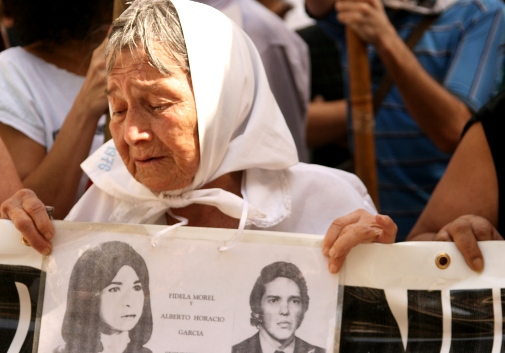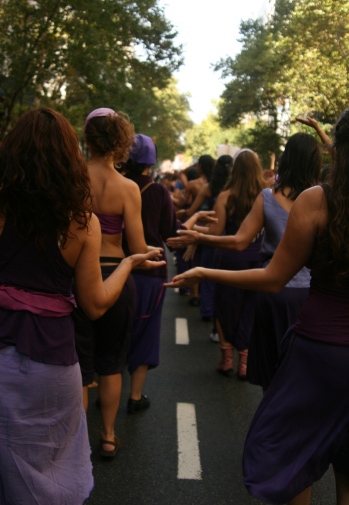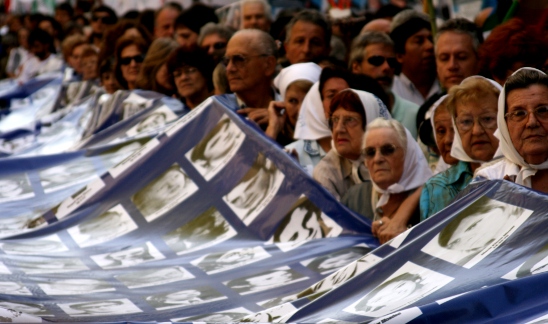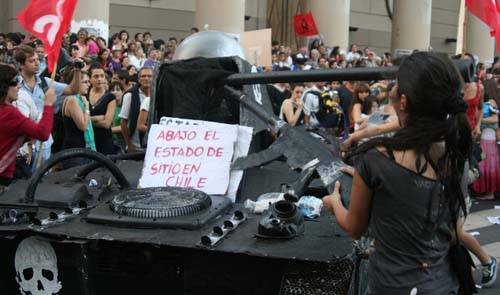 "With regular jails overflowing, you (the military) turned the principle garrisons in the country into virtual concentration camps, where no judge, lawyer, journalist or international observer enters. The military keeping the proceedings as secret, invoked as the need for interrogation, has transformed most detentions into kidnappings that allow you to torture limitlessly and execute prisoners with no trial." — Rodolfo Walsh, political writer disappeared after he penned the text, "Open Letter to the Military Junta" published on March 24, 1977, the first anniversary of the coup.
"With regular jails overflowing, you (the military) turned the principle garrisons in the country into virtual concentration camps, where no judge, lawyer, journalist or international observer enters. The military keeping the proceedings as secret, invoked as the need for interrogation, has transformed most detentions into kidnappings that allow you to torture limitlessly and execute prisoners with no trial." — Rodolfo Walsh, political writer disappeared after he penned the text, "Open Letter to the Military Junta" published on March 24, 1977, the first anniversary of the coup.
Tens of thousands in Argentina recently marked the 34th anniversary of the nation’s bloody military dictatorship, flooding into the historic Plaza de Mayo with cries of nunca más, or never again. On March 24, 1976 the military ceased power and instituted one of Latin America’s darkest chapters of terror. During the 1976-1983 junta, the military disappeared more than 30,000 people.
Since the 30th anniversary of the coup, in 2006, protests to repudiate the military coup have grown in size and political importance; at this year’s protest more than 25,000 people overflowed the Plaza de Mayo while major human rights trials are underway. The Mothers and Grandmothers of Plaza de Mayo led the march carrying a banner with photos of the disappeared. The black and white portraits extended for blocks, with thousands of photos of unionists, students, artists, intellectuals, workers, lawyers, mothers, fathers, sons, daughters and compañeros, many of whom were only in their 20s when commando groups kidnapped them to take them to clandestine detention centers, torture and later disappear this generation which dreamt of a better world. This generation was reflected in the outpouring on March 24, 2010, and in the collective screams of "30,000 disappeared-present! Now and Forever!"
Open door to justice
Nearly 27 years after Argentina’s return to democratic rule, the country is revisiting its painful past with human rights trials. Many have called 2010 the year of the human rights trials. More than eight high-profile trials are underway, prosecuting dozens of military, police and civilians accused of torture, murder, kidnapping and disappearances. The recent release of classified military files may also lead to more prosecutions and answers as to what happened to Argentina’s 30,000 disappeared.

Until 2003, amnesty laws foreclosed any successful prosecution of ex-military leaders for human rights crimes by the courts. Even when prosecution was impossible, human rights groups continued to gather information as to the whereabouts of the disappeared, collect evidence and testimonies, and to demand justice and an end to impunity. However, a 2003 Supreme Court order overruled the Due Obedience and Full Stop laws passed in the early 1990’s which protected officers from the possibility of facing charges.
The dimension of the crimes of those prosecuted is unimaginable. And the number of prosecuted and facing criminal proceedings falls short considering the complex system of kidnapping, torture, murder and disappearance that ensued during the dark years of the dictatorship. The most painful component for many is the significance of disappearances, and the open wounds left behind by not knowing exactly what happened to the victims and their bodies. Disappearances, a cornerstone in the lexicon of terror devised by the military dictatorship, persist as a social stigma and an uncomfortable void of the recent past.
ESMA trial
"March 24 not only compels us to reflect on the past, but also to reflect on our future and current challenges," says Victoria Donda, a national deputy whose parents were disappeared at the same detention center where her mother gave birth. Donda was born at the ESMA Navy Mechanics School while her mother was in captivity at the clandestine detention center. She lived most of her life with appropriators, who never told her about her past. She recuperated her identity in 2003 at the age of 26. More than 500 children were kidnapped by the dictatorship and raised with false identities. The human rights group Grandmothers of Plaza de Mayo, has strived to find all of the children, so far they have recuperated the identity of 101 children, who are now in their 30’s.

The ESMA trial, one of the largest human rights trials in Latin America’s history opened in December 2009. In total, 19 officers who worked at the ESMA face charges of kidnapping, torture and murder of 86 people. However, it is estimated that nearly 5,000 were disappeared inside the ESMA barracks, as the largest clandestine detention center that operated during the dictatorship. Donda will testify in the trial, and says, "We are living in a country where the people who participated in the crimes during the dictatorship are being tried, [but] these are not the type of trials that we want, nor are they as fast as we’d like, nor are all the people involved in the abuses on trial; however, these are the trials that we have and they are progressing."
Surviving testimonies
More than 300 clandestine detention centers operated during the dictatorship, shedding light on the magnitude of state terrorism carried out from 1976-1983. Many of the victims in Buenos Aires and surrounding neighborhoods were thrown from planes into the sea after being drugged.
Aside from the ESMA, other clandestine torture centers operated in the nation’s capital. Inside the Atlético, Banco and Olimpo, three separate secret detention sites, thousands were tortured and disappeared. Ramiro Poce’s father was disappeared from the Garage Olimpo, one of the clandestine detention centers in a trial of the Buenos Aires circuit of clandestine detention centers. "The Due Obedience and Full Stop laws prohibited the proceedings against military. Thanks to the reversal of those laws we are able to slowly begin the trials," says Poce. He will testify in the trial, to give testimony of his father’s kidnapping by a commando group. Some 17 military and police are being prosecuted in this trial. For many, the trials mark a new chapter in Argentina’s history. "Each time the trials began, it is a step towards building a true democracy and prosecuting those who staged a coup against the nation and the entire population."
Military officers have begun to testify in their defense, failing to provide information or confess; on the contrary some defend their actions as following military orders to "fight a war against subversion." For the first time, Rafael Videla appeared in court in March; however hundreds of police protected the former dictator from news cameras.
Slow justice
During this year’s massive march for the commemoration of Argentina’s 30,000 disappeared, protestors and human rights groups expressed immediate concerns about delays in legal proceedings and resistant judges contributing to delays in the human rights trials. "Only a few who formed part of this genocide are being tried in the justice system. There are still a lot left to be charged," said Estela Carlotta, president of Grandmothers of Plaza de Mayo, reading from a document written by human rights groups on March 24. Organizers from this year’s march demanded, "the political decision to give more resources to the Justice system, in larger court rooms and truly public trials. Society has already condemned the murders and we won’t allow for forgiveness, amnesty or reconciliation for those responsible."

The government official Victoria Donda admits that the judicial system has been slow to reform and is filled with accomplices from the dictatorship who still have not been prosecuted for their actions. A recent article in the national daily Pagina/12 revealed that several judges are being investigated in the province of Mendoza for human rights abuses committed during the dictatorship. Other irregularities have surfaced such as the same judge overseeing trial proceedings in two different provinces, which has delayed another major human rights trial of the Massacre of Margarita Belen for over a year and a half. The higher courts have also agreed to change judges, following the defendants’ request, all with the purpose of tying up proceedings. "In the provinces of Salta and Jujuy they do not have an adequate space to hold the trials. And they purposefully held the ESMA trial in a court room so small [that] space for observers, media and activists from attending all the court sessions has been limited," says Donda.
Breaking the wall of impunity
This year’s massive march reflects the passionate cries for the trials to continue, and that all military and accomplices involved in the brutal terror be brought to justice. But protestors came out not to close the dark chapter of history, but to turn the pages in the construction of a new future that values democracy and human rights.
March 24 is now considered a national holiday, "a national day of memory for justice and truth," a day on which schools and public offices are closed. President Cristina Fernandez de Kirchner has supported the trials, but has also polarized the human rights movement. The president turned the official commemorations into a rally for the President, while creating tensions between human rights groups critical of the government’s economic policies and failure to provide the judicial system with enough resources to carry out the trial. While the president released an important document with the names of 4,300 people who worked in the armed force battalion 601, one of the largest intelligence agencies of the Armed Forces, more documents remain to be disclosed. The agency was used to collect information on activists which led to their disappearances, among the ranks of the thousands of names of people now in their 50s and 60s are not only military but civilians, professionals who have yet to be tried for their participation in the dictatorship. Human rights groups report that intelligence officers continue to infiltrate social movements and political organizations.
Among those demanding justice are the Mothers and Grandmothers of Plaza de Mayo, which for over 30 years have used pacifist tactics to demand justice and truth about what happened. For Latin America, these groups have exemplified the regional struggle for democracy and sovereignty, in a hemisphere plagued by dictatorships in the 1970s and 1980s which disappeared over 90,000 people according to The Latin American Federation of Associations for Relatives of the Detained-Disappeared (FEDEFAM). Argentina, thanks to the endless work of human rights groups, is paving the way for other countries to revisit their painful past. Without justice for crimes committed in the past, the military and repressive forces in the region will have the power to act with impunity as we are seeing with an active coup in Honduras, military in the streets of Chile and U.S. military bases in Colombia. Militarization remains a risk for the region, and with long-standing impunity for military crimes Latin America could lose another generation. However, a new generation of human rights advocates in Argentina is trying to break this wall of impunity through the legal system for long-standing justice.
Marie Trigona is a writer, radio producer and translator based in Argentina. She can be reached through her blog www.mujereslibres.blogspot.com All photos by Marie Trigona
